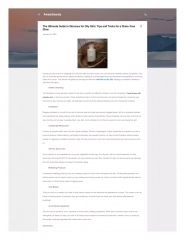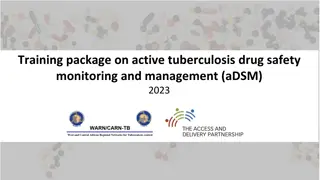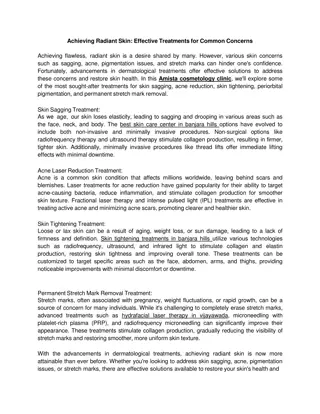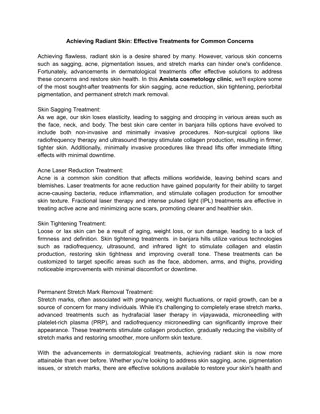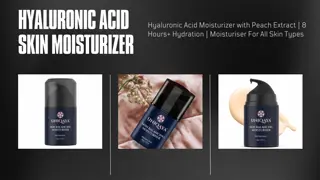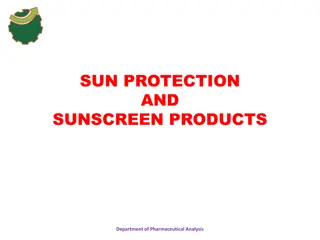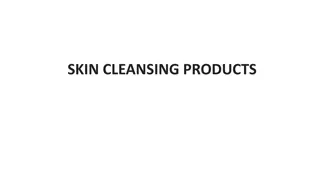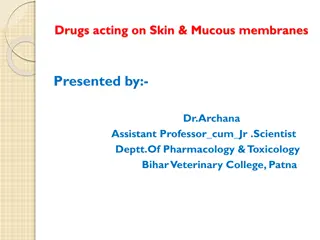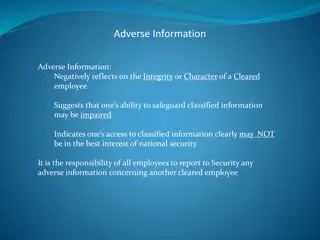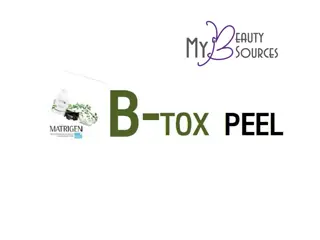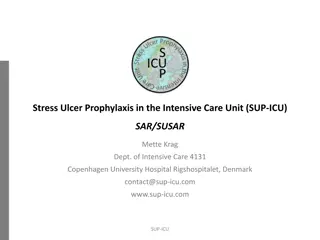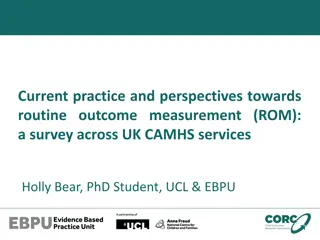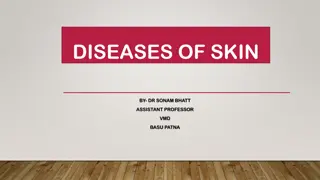Understanding Skin Sensitisation through Adverse Outcome Pathways (AOP)
The Adverse Outcome Pathway (AOP) for Skin Sensitisation provides a mechanistic framework linking Molecular Initiating Events (MIE) to Adverse Outcomes (AO) through Key Events (KE) and Key Event Relationships (KER). AOPs offer a transparent justification for toxicological predictions and play a vital role in the development of the QSAR Toolbox. This concept simplifies the complex progression of events by focusing on critical steps, enhancing chemical similarities, and reducing uncertainties in toxicological assessments.
Download Presentation

Please find below an Image/Link to download the presentation.
The content on the website is provided AS IS for your information and personal use only. It may not be sold, licensed, or shared on other websites without obtaining consent from the author. Download presentation by click this link. If you encounter any issues during the download, it is possible that the publisher has removed the file from their server.
E N D
Presentation Transcript
1 The Adverse Outcome Pathway (AOP) for Skin Sensitisation (SS): How We Got Here and Where We are Going T. W. Schultz Professor Emeritus The University of Tennessee, College of Veterinary Medicine, Knoxville, TN USA
Topics 2 The AOP concept History of the AOPs and development of the AOP for SS AOP functionalities in the Toolbox Future activities
Adverse Outcome Pathways 3 AOPs depict existing knowledge which links two anchor points, the Molecular Initiating Event (MIE), and an Adverse Outcome (AO). They link these anchor points by a series of Key Events (KE) and the relationships between them (KER). The KEs are a limited number of measurable and toxicologically-relevant actions which are essential for the development to the AO.
AOP Concept 4 AOPs are typically represented sequentially by moving from one KE to another, as compensatory mechanisms and feedback loops are overcome. An AOP is not required to provide a comprehensive molecular description of all aspect of the chemistry and biology, rather it focuses on critical steps in the progression of events.
AOP Concept 5 The AOP concept provides a means of documenting transparent mechanistic justification and weight-of-evidence which increase chemical similarities and reduce uncertainties in the predictions for complex toxicological endpoints. It is generally considered to be a focal point of future development of the QSAR Toolbox.
Molecular Initiating Event Macro -Molecular Interactions Toxicant Biological Responses Apical Outcome Receptor, DNA, Protein Interactions Chemical Profiles Mechanistic Profiling The OECD QSAR Toolbox as of 2010
Molecular Initiating Event Macro -Molecular Interactions Cellular Organism Organ Population Toxicant Lethality Gene Activation Altered Function Sensitization Receptor, DNA, Protein Interactions Structure Chemical Profiles Protein Production Birth Defect Altered Development Extinction Signal Alteration Reproductive Impairment Cancer Mechanistic Profiling Cellular & In Vitro Sub- Profiling In Vivo Sub-Profiling The Future OECD QSAR Toolbox as envisioned in 2010
History of the AOP 8 McKim Conference on Predictive Toxicology Using Toxicity Pathway Models in Predictive Toxicology Duluth, Minnesota September 16-18, 2008 Toxicity Pathways as an Organizing Concept Gilman Veith Applying Adverse Outcome Pathway Concepts to ER-mediated Effects Pat Schmieder
History of AOP at OECD 9 OECD 2011a. Report of the Workshop on Using Mechanistic Information in Forming Chemical Categories. OECD Environment, Health and Safety Publications Series on Testing and Assessment No. 138. ENV/JM/MONO(2011)8. It is recommended that over the next two years (i.e., the near term) a number of tasked be undertaken including: Develop AOPs for well-established effects (e.g., skin sensitisation). Establish the work flow for using AOPs in categorisation and read-across (i.e., integrating AOPs in the QSAR Toolbox).
History of AOP at OECD 10 OECD 2011b. Report of the Expert Consultation on Scientific and Regulatory Evaluation of Organic Chemistry-based Structural Alerts for the Identification of Protein-binding Chemicals. OECD Environment, Health and Safety Publications Series on Testing and Assessment No. 139. ENV/JM/MONO(2011)9. OECD 2012a. The Adverse Outcome Pathway for Skin Sensitisation Initiated by Covalent Binding to Proteins Part 1: Scientific Evidence. OECD Environment, Health and Safety Publications Series on Testing and Assessment No. 168, Part 1. ENV/JM/MONO(2012)10/PART1. OECD 2012b. The Adverse Outcome Pathway for Skin Sensitisation Initiated by Covalent Binding to Proteins. Part 2: Use of the AOP to Develop Chemical Categories and Integrated Assessment and Testing Approaches. OECD Environment, Health and Safety Publications Series on Testing and Assessment No. 168, Part 2. ENV/JM/MONO(2012)10/PART2.
AOP for SS Cellular Response Organ Response Organism Response Molecular Initiating Event Chemical Structure & Properties Dendritic cells (DCs) Lymph node In chemico /in sliico reactivity Skin Induction of inflammatory cytokines and surface molecules Mobilization of DCs (epidermis) Absorption Metabolism Inflammation upon challenge with allergen Covalent interaction with proteins Histocompatibility complexes presentation by DCs Activation of T cells Proliferation of activated T-cells Keratinocytes Activation of inflammatory cytokines Induction cyto- protective gene pathways Electrophilic substance l Adapted from The Adverse Outcome Pathway for Skin Sensitisation Initiated by Covalent Binding to Proteins. Part 1: Scientific Evidence OECD ENV/JM/MONO(2012) 10 PART 1
Why was the SS AOP so successful? 12 Many things came together at the right time: Firstly, more than 2 decades of work by industry and academia had provided the nodes and key events. Secondly, Toxicity for the 21stCentury was looking of an application. The Toolbox had grown in acceptance and was looking to expand. Regulators were looking for ways of integrating alternative data.
What are some of the outcomes of the SS AOP? 13 The AOP concept has become scientifically accepted. Several different Integrated Assessment and Testing Approached based on AOPs have been proposed. All of which clearly lead to the reduction or elimination of the use of animals in hazard and risk assessment. Non-in vivoand New Methods assays and data are being developed and looked at with regards to their relevance to AOPs. The OECD has established an AOP program.
Implemented in Toolbox As: 14 An in silico scheme is associated with specific databases and profilers (KEY NODES) within the Toolbox. A workflow associated with filtered Toolbox functionalities (KEY EVENTS) A proof-of-concept in Version 3.0
AOP Windows in the Toolbox 15 Panel with predictions/measured data assigned to the selected node Panel with full names of nodes Indication for assigned prediction AOP tree scheme Selected node Color legend Panel with unassigned predictions Panel with information for selected node Short description Target chemical
16 Key Nodes and Key Events Key Nodes Key Events 1 Protein binding alerts 1) Protein binding in silico/theoretical 2a in chemico Peptide depletion assay DPRA (Cys) 2b in chemico Peptide depletion assay DPRA (Lys) 2) Protein binding potency in chemico 2c in chemico Glutathione depletion assay GSH (RC50) 2d in chemico Adduct formation assay LC-MS 3 in vitro Keratinocyte ARE (EC1.5, EC2, EC3) 3 & 4)Cellular response 4a in vitro Dendritic cell activity assay h-CLAT (expression of CD54 and CD86) 4b in vitro Dendritic cell activity assay MUSST (expression of CD86) in vivo Organ response (LLNA) 5 5) Organ response 6 6) Organism response in vivo Organism response (GPMT)
Workflow Along Nodes and Key Events 17 In vitro: gene expression assay In vivo: Organism response (GPMT) In vivo: Organ response (LLNA) MIE: protein binding In vitro: cytokine profiles in dendritic cells In chemico: protein binding potency assays
Thresholds of the AOP Nodes 18 Node name Data/profiling result thresholds Node status: Pass Node status: Not pass 1- Protein binding alerts presence of alert absence of alert 2a and 2b in chemico DPRA Cys and Lys Peptide depletion, PD (%) > 80 - High 40% PD 80% Moderate 80% PD 40% Low 5%< PD Not reactive High |Moderate | Low Not Reactive 2c - in chemico Glutathione depletion assay GSH (RC50) RC50 (mmol/L) 0.099 Extremely reactive 0.1 RC50 0.99 Highly reactive 1 RC50 15 Moderately reactive 16 RC50 70 Slightly reactive 70.1 RC50 135 Suspect RC50 > 135 Not reactive Extremely Reactive| Highly Reactive | Moderately Reactive | Slightly Reactive Suspect |Not Reactive | Not reactive at saturation 2d - in chemico Adduct formation assay LC-MS Adduct formation (%) 30% - Positive Adduct formation (%) < 30% - Negative Positive Negative 3 - in vitro Keratinocyte ARE (EC1.5, EC2, EC3) EC3 (%) 20 Very high 20 > EC3 50 High 50 > EC3 100 Moderate 100 > EC3 2000 Low EC3 > 2000 - Negative Very High |High| Moderate | Low Negative 4a and 4b in vitro Dendritic cell activity assay h-CLAT and MUSST (expression of CD54 and CD86) expression of CD54 and CD86 Positive Negative Positive Negative 5 - in vivo Organ response (LLNA) 0 EC3 (%) <50 Positive EC3 > 50 - Negative Positive Negative 6 - in vivo Organism response (GPMT) Data provided: Strong sensitizer; Moderate sensitizer; Weak sensitizer; Non sensitizer Strong sensitizer |Moderate sensitizer Weak sensitizer |Non sensitizer
As A Proof-of-Concept 19 Data for most key nodes limited to about 70 compounds. Profilers were incomplete. Cut off value for potency classes were simple estimates. The assessment was limited to sensitiser or non- sensitiser. The work flow was not streamlined.
Future Activities 20 Data sets for most key nodes will be expanded to more that 200 discrete compounds. Current profilers will be revised. Potency classes will be refined and assessments of sensitisation be made more quantitative. New nodes (e.g., LuSens, SENS-IS, GARD, human in vivo) may be added. The work flow will be streamlined.
In Closing 21 The development of the SS-AOP would not have been possible without the work of many people. I am honored to represent them here. For SS, the AOP has brought the promise of the third R (replacement) to a near-term reality. Thank you for your attention!


